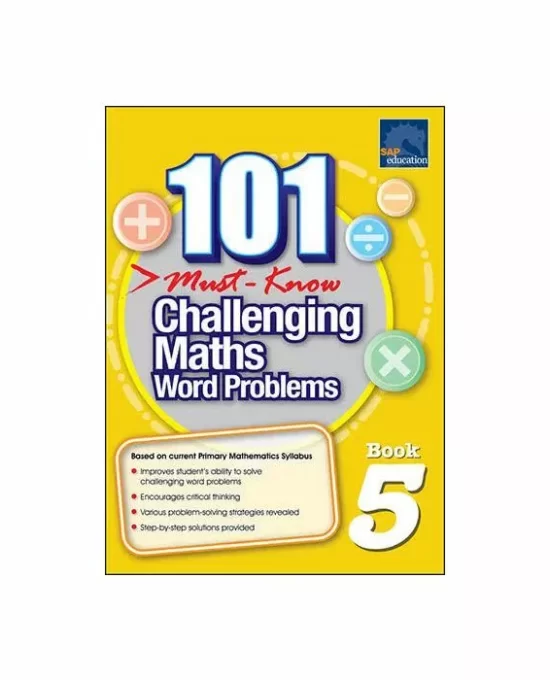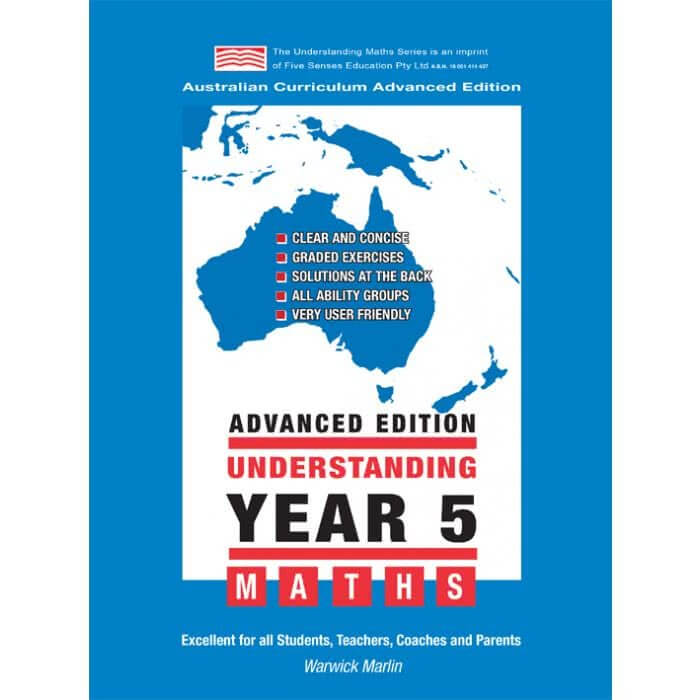Maths Test Bank Year 5
$22.95
ISBN 9781760323288
Maths Test Bank is a total maths assessment solution that provides both assessment of learning and assessment for learning. Linked explicitly to the Australian Curriculum and NSW Syllabus for the Australian Curriculum, Maths Test Bank blends seamlessly with any maths teaching resource or approach.
Maths Test Bank:
- is easy for students and parents to follow
- provides teachers with assessment content that shows basic understanding and fluency of a topic, and also provides students with content that enables them to:
- think about their understanding of a topic
- extend themselves by applying the concepts further or by comparing different ways of working
- show and explain the way they have solved a problem or why a method does or doesnt work
- provides evidence of a students level of achievement in every content strand of mathematics (assessment of learning), but also provides teachers with verification of a students proficiency level in the key areas of understanding, fluency, problem solving and reasoning (assessment for learning)
- includes a grading guide and suggestions for students who are achieving beyond or below the expected level of achievement.
Part 1: Assessment of Learning
The assessment of learning is designed to help the teacher (and the student) measure progress towards achievement standards. The aim of this assessment is to find out what a student has learned and to help answer questions such as:
- Where was the student?
- Where is the student now?
- Where does the student need to go to next?
Part 2: Assessment for Learning
Assessment for learning differs from assessment of learning because its main focus is inquiry into the learning process. Teachers are able to look at the way students learn, rather than at their level of achievement. This analysis can then inform future teaching and learning requirements.
This assessment focuses on students level of development in the proficiency strands of the mathematics curriculum (understanding, fluency, problem solving and reasoning) and their ability to reflect on, reason, explain, explore and adapt key mathematical concepts.
Additional information
| Publish Type | |
|---|---|
| Subject | |
| Year Level |
You may also like…
Maths Test Bank Year 6
- Where was the student?
- Where is the student now?
- Where does the student need to go to next?
-
Contents
- Assessment of and for Learning: Introduction
- Grading Guide
- Curriculum Overview
- Assessment of and for Learning: The Tests
- Number and Algebra
- 1A Place value
- 1B Number properties
- 1C Mental strategies for addition and subtraction
- 1D Written strategies for addition and subtraction
- 1E Mental strategies for multiplication and division
- 1F Written strategies for multiplication and division
- 1G Integers
- 2A Fractions
- 2B Addition and subtraction of common fractions
- 2C Decimal fractions
- 2D Addition and subtraction of decimals
- 2E Multiplication and division of decimals
- 2F Decimals and powers of ten
- 2G Percentage, fractions and decimals
- 3A Geometric patterns
- 3B Number patterns
- 3C Order of operations and equations
- Measurement and Geometry
- 4A Length
- 4B Area
- 4C Volume and capacity
- 4D Mass
- 4E Timetables
- 5A Angles
- 5B 2D shapes and 3D objects
- 6A Transformations
- Statistics and Probability
- 7A Representing data
- 6B Cartesian coordinate systems
-
- 7B Interpreting data
- 7C Data in the media
- 7D Probability
- 7E Chance experiments and simulations
- From Assessment to Instruction: Teacher Support
- Answers
Maths Test Bank Year 6
- Where was the student?
- Where is the student now?
- Where does the student need to go to next?
-
Contents
- Assessment of and for Learning: Introduction
- Grading Guide
- Curriculum Overview
- Assessment of and for Learning: The Tests
- Number and Algebra
- 1A Place value
- 1B Number properties
- 1C Mental strategies for addition and subtraction
- 1D Written strategies for addition and subtraction
- 1E Mental strategies for multiplication and division
- 1F Written strategies for multiplication and division
- 1G Integers
- 2A Fractions
- 2B Addition and subtraction of common fractions
- 2C Decimal fractions
- 2D Addition and subtraction of decimals
- 2E Multiplication and division of decimals
- 2F Decimals and powers of ten
- 2G Percentage, fractions and decimals
- 3A Geometric patterns
- 3B Number patterns
- 3C Order of operations and equations
- Measurement and Geometry
- 4A Length
- 4B Area
- 4C Volume and capacity
- 4D Mass
- 4E Timetables
- 5A Angles
- 5B 2D shapes and 3D objects
- 6A Transformations
- Statistics and Probability
- 7A Representing data
- 6B Cartesian coordinate systems
-
- 7B Interpreting data
- 7C Data in the media
- 7D Probability
- 7E Chance experiments and simulations
- From Assessment to Instruction: Teacher Support
- Answers
101 Must Know Challenging Maths Word Problems Book 5
101 Must-Know Challenging Maths Word Problems for Primary 5 presents word problems that test important concepts so students can learn to apply general mathematical problem-solving strategies and heuristics confidently.
This book comprises word problems often encountered by students in their tests and examinations. The questions are categorised into respective topics in accordance with the topics in the Singapore mathematics syllabus.
101 Must Know Challenging Maths Word Problems Book 5
101 Must-Know Challenging Maths Word Problems for Primary 5 presents word problems that test important concepts so students can learn to apply general mathematical problem-solving strategies and heuristics confidently.
This book comprises word problems often encountered by students in their tests and examinations. The questions are categorised into respective topics in accordance with the topics in the Singapore mathematics syllabus.
Understanding Year 5 Maths Advanced: Australian Curriculum Edition
This advanced edition of Understanding Maths Year 5 provides graded exercises that will test student of most ability groups, and in many of the chapters, will extend students to concepts which are usually covered in Year 6. The questions are graded into levels of difficulty:
- Easier questions: These Level 1 (and sometimes Level 2) questions are intended to build confidence and follow the format of the examples.
- Average questions: Level 2 & 3 questions are of average difficulty level, and give all students (weak, average & gifted) a good opportunity to practice and consolidate the ideas and rules given throughout most of the chapter. All students should try to complete and understand questions in the first three levels.
- Harder questions: These questions are more difficult as they involve larger numbers, and some of the more difficult ideas in the related topic. Reference pages numbers and not included so that students learn to search through the chapter for the relevant information.
- Problem solving: This more difficult level has been included to challenge those students who are more gifted at Maths. Usually the questions are more sentence and problem oriented, and therefore they involve more reading and comprehension skills. It is unlikely that any of the questions in this level can be done mentally, because several different ideas, rules or steps are usually required.
Contents
- Introduction
- Number & Algebra
- Number and Place Value
- Fractions and Decimals
- Money and Financial Mathematics
- Patterns and Algebra
- Measurement & Geometry
- Using Units of Measurement
- Shape
- Location and Transformation
- Geometric Reasoning
- Statistics & Probability
- Chance
- Data Representation and Interpretation
Understanding Year 5 Maths Advanced: Australian Curriculum Edition
This advanced edition of Understanding Maths Year 5 provides graded exercises that will test student of most ability groups, and in many of the chapters, will extend students to concepts which are usually covered in Year 6. The questions are graded into levels of difficulty:
- Easier questions: These Level 1 (and sometimes Level 2) questions are intended to build confidence and follow the format of the examples.
- Average questions: Level 2 & 3 questions are of average difficulty level, and give all students (weak, average & gifted) a good opportunity to practice and consolidate the ideas and rules given throughout most of the chapter. All students should try to complete and understand questions in the first three levels.
- Harder questions: These questions are more difficult as they involve larger numbers, and some of the more difficult ideas in the related topic. Reference pages numbers and not included so that students learn to search through the chapter for the relevant information.
- Problem solving: This more difficult level has been included to challenge those students who are more gifted at Maths. Usually the questions are more sentence and problem oriented, and therefore they involve more reading and comprehension skills. It is unlikely that any of the questions in this level can be done mentally, because several different ideas, rules or steps are usually required.
Contents
- Introduction
- Number & Algebra
- Number and Place Value
- Fractions and Decimals
- Money and Financial Mathematics
- Patterns and Algebra
- Measurement & Geometry
- Using Units of Measurement
- Shape
- Location and Transformation
- Geometric Reasoning
- Statistics & Probability
- Chance
- Data Representation and Interpretation



